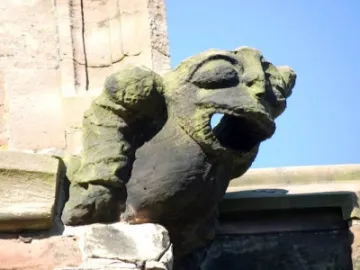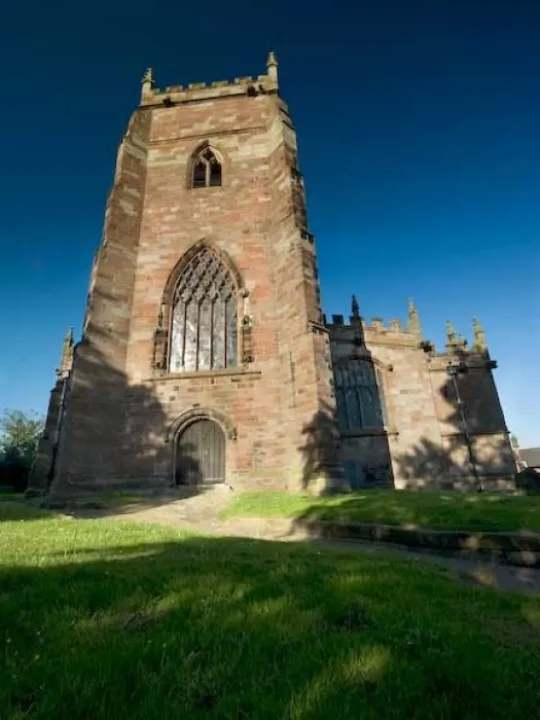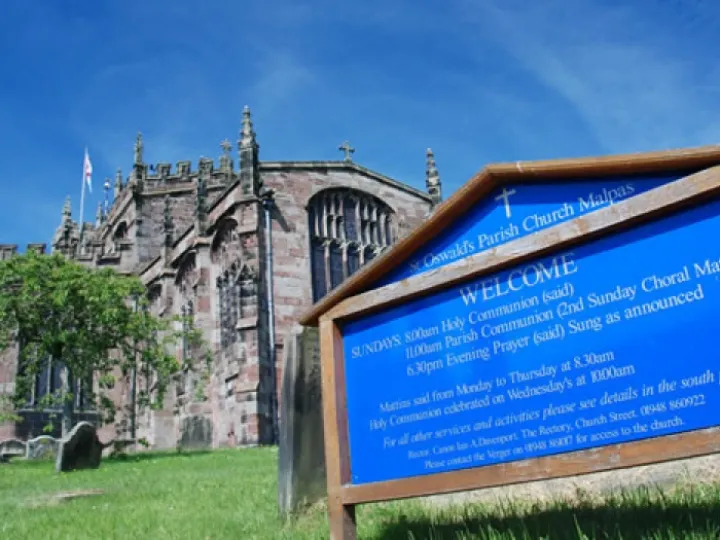St Oswald's Church
This ancient church is situated at the heart of the small town of Malpas. It is a fine example of medieval architecture and has witnessed to the truths of the Christian faith for over 1,000 years. The present church probably stands on the site of the former private chapel to Malpas Castle, which was erected soon after the Norman Conquest of 1066.
The present building mainly dates from the middle of the fifteenth-century.
The church is very much involved in the life of the town and wider community, and has particularly strong links with the local primary school where the incumbent is one of the board of Governors.
Read more about St Oswald's, Malpas, on Wikipedia
More facts on the Church of Saint Oswald
The Church of Saint Oswald stands at the highest point of the village, near the site of a Norman motte and bailey castle. St. Oswald's is a Grade I listed building and is recognised as being one of the finest examples in England of a late 15th century church. It is an active Anglican parish church in the diocese of Chester, the archdeaconry of Chester and the deanery of Malpas. Its benefice is combined with that of St John's, Threapwood and Holy Trinity, Bickerton.
History
The church is dedicated to St Oswald, the "Saintly King" of Northumbria who, according to the venerable Bede, was killed in battle against Pendra, the heathen King of Mercia at Maserfield (near Oswestry) in 642AD.
Although no structure remains of the original chapel, the earliest parts of the existing building , including the Tower, date from the late 1300's and house a fine set of Bells.
Structue
St. Oswald's is built in red sandstone with lead roofs. The tower, which houses a fine set of bells, dates from the 14th century and is just over 70 feet (21 m) high with diagonal west buttresses, angled east buttresses, and a southeast octagonal turret.
The nave and chancel are crenellated. The nave ceiling is constructed with camber beams and it has bosses and carved angels.
At the eastern end of each aisle is a chantry chapel, the north chapel originally belonging to the Cholmondeley family and the south chapel to the Brereton family. At either side of the base of the Chancel are carved grotesque faces. These were the springer stones which acted as the bases of earlier arches which extended along the length of the nave.
To the east of the nave is the three-bay chancel and in the north-east corner is a vestry dating from 1717.
At the south-west corner is a porch which leads into a six-bay nave with north and south aisles.
Above the south porch is a parvise and above the doorway is a wall sundial with niches on either side. The porch is embattled, with pinnacles and gargoyles.
Fittings and furniture
Within the nave is an oak and iron work chest dating from around 1250, which is a little older than the wooden misericords – the sets of carved hinged seats located near the organ.
The octagonal font is from the 15th century and it has an oak cover made in 1627.
The pews date from the 1880's, but some of the original box pews from the Brereton chapel are now at the back of the south aisle.
Above the chancel arch is a painting of St Peter's Denial of Christ by Hayman together with three pairs of hatchments belonging to the Dod family of Edge Hall, the Tarleton family formerly of Bolesworth and the Cholmondeley family of Cholmondeley Castle. The Hatchments were the coats of arms that were carried at funerals of wealthy families.
Within each chantry chapel is a tomb. In the Brereton chapel the tomb is that of Sir Randal Brereton and his wife and is dated 1522.
The monument in the Cholmondeley chapel was erected in 1605 and represents Sir Hugh Cholmondeley and his second wife, Mary. Also in this chapel is a memorial by Westmacott to Lady Cholmondeley who died in 1815.
In the chancel is a memorial tablet by Edward Hilton to Charles Wolley Dod who died in 1904 .
In the nave is a slab to Urian Davenport, rector of Malpas who died in 1495. In the south aisle are tablets to John Stockton who died in 1700 and Bridget Kynaston who died in 1644. In the north aisle is a memorial by Edwards & Co. of Wrexham to Lt. Col. Henry Tarleton who died in 1820.
On the south side of the chancel is a triple sedilia and a piscina. The altar piece was presented by a Mr Drake in 1721.
Against the south wall of the chancel are three 15th century stalls with misericords.
Most of the stained glass is Victorian but Flemish roundels, which came from Cholmondeley Castle, date from 16th and 17th Centuries.
Also present are several panels dating from the 16th century and many Netherlandish medallions dating from the 16th and 17th centuries.
The stained glass includes a panel in the north chapel dating from around 1500 depicting the Presentation in the Temple.
One window by Kempe in the south aisle is dated 1902. The east window is a memorial to Bishop Heber who was born in the town.
From the sanctuary, a staircase leads down to a vaulted crypt below the altar which was formerly a treasury.
The church plate includes a chalice dated 1674 and two silver patens of 1742.
The parish registers date from 1561 and the churchwardens' accounts from 1653.
The ring consists of eight bells. Four of these were cast by John Rudhall in 1802, and the other four were by John Taylor & Co, two of these being dated 1908 and the other two in 1914.
External features
Parts of the churchyard wall are listed Grade II.
Within the churchyard are a number of items listed Grade II, namely, a table tomb dedicated to members of the Duncall family, the tomb of John Bassett, a headstone to the Hobley family and a sandstone sundial pedestal dating probably from the early 18th century.
Listed Grade II* are the gate piers and steps at the south-west corner of the churchyard and the gates, gate piers and steps at south-east corner of churchyard. They were originally made for Oulton Park in the 1720s at the time of John Vanbrugh's work there. They were moved to Malpas churchyard around 1773. The gate piers and steps to the west gateway to the churchyard are listed Grade II as are the gate piers and steps to a small gateway at the southeast corner of the churchyard.
Building Extensions and Restoration Works
In the 1490's, the height of the church was increased. A clerestory (the high windows illuminating the nave) and a camber roof beam was constructed to replace the earlier pitched roof.
The original position of this earlier roof can still be seen from inside the church, on the walls above the arches leading into the Chancel and into the Tower.
The font dating from the 1400's with its wooden cover dated at 1627 was restored in the mid twentieth century.
In the 1960's the roof was restored and many of the bosses and Angles were repainted and re-gilded.
The roof was restored and many of the bosses and angels repainted and re-gilded in the 1960's.
The two-manual organ was built in 1897 by Lewis & Co Ltd, overhauled around 1962 by Rushworth and Dreaper and restored by Peter Collins Limited in 2001.
The most recent large vital repair work was in 2011, when the re-leading of the main roof cost in excess of £150,000.
Gargoyles and Grotesques

In common with many other medieval churches of the time, St. Oswald's has a number of gargoyles and grotesques. The difference between the two, architecturally speaking, is a gargoyle has a practical purpose, being a device to throw water away from the building, often through it's mouth; whereas a grotesque, or chimera, simply serves as ornamentation.
Past Links
In the Brereton side chapel one of their children, William is depicted at the base of his parent's memorial. When he grew up he attended the court of King Henry VIII and was tortured and executed for his (supposed) romance with the Queen – Anne Boleyn.
The painting by Francis Hayman, located above the chancel arch shows St Peter's denial of Christ. In 1768, Hayman was a founding member of the Royal academy and counted William Hogarth, Sir Joshua Reynolds and the composer Handel among his friends.
The window above the Altar depicts the life of Bishop Heber, who was born in Malpas Rectory. He was a great hymn writer (Holy, Holy, Holy, Brightest and Best are the sons of the Morning) and eventually became Bishop of Calcutta. He died just 43.
Quick Links
Village Map
Get In Touch
MalpasOnline is powered by our active community.
Please send us your news and views using the button below:



